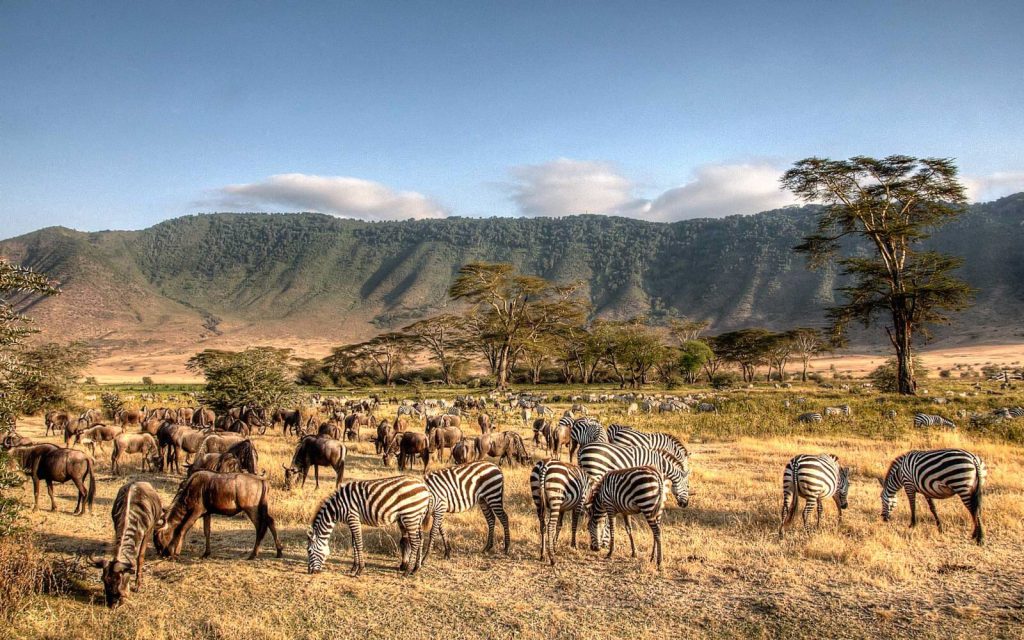TANZANIA DESTINATIONS
NGORONGORO CONSERVATION AREA
Highlights
The jewel in Ngorongoro/s crown is a deep, volcanic crater formed nearly 2.5 millions years ago, the largest un flooded and unbroken caldera in the world. About 20 kms across, 600 meters deep and 300 sq kms in area, the Ngorongoro Crater is a breathtaking natural wonder.
The Ngorongoro Crater is one of Africa’s most famous sites and is said to have the highest density of wildlife in Africa. Sometimes described as an ‘eighth wonder of the world’, the Crater has achieved world renown, attracting an ever-increasing number of visitors each year. You are unlikely to escape other vehicles here, but you are guaranteed great wildlife viewing in a genuinely mind-blowing environment. There is nowhere else in Africa quite like Ngorongoro!
Geological records show that the cone of the volcanic caldera collapse inwards, forming what is currently known as a crater. The site is named after a Maasai phrase, ‘orgirra le kkorongorro,’ which means “Big Bowl.” Earlier documentation of the area misspelled the word ‘kkorongorro’ into today’s Ngorongoro with its intricate depth ‘caldera/crater,’ resulting in Ngorongoro Crater.
The Ngorongoro Crater is the world’s largest intact volcanic caldera. Forming a spectacular bowl of about 265 square kilometres, with sides up to 600 metres deep; it is home to approximately 30,000 animals at any one time. The Crater rim is over 2,200 metres high and experiences its own climate. From this high vantage point it is possible to make out the tiny shapes of animals making their way around the crater floor far below. Swathes of cloud hang around the rocky rim most days of the year and it’s one of the few places in Tanzania where it can get chilly at nigh.
The crater floor consists of a number of different habitats that include grassland, swamps, forests and Lake Makat (Maasai for ‘salt’) – a central soda lake filled by the Munge River. All these various environments attract wildlife to drink, wallow, graze, hide or climb. Although animals are free to move in and out of this contained environment, the rich volcanic soil, lush forests and spring source lakes on the crater floor (combined with fairly steep crater sides) tend to incline both grazers and predators to remain throughout the year.
Ngorongoro Crater Wildlife
Ngorongoro Crater is one of the most likely areas in Tanzania to see the endangered Black Rhino, as a small population is thriving in this idyllic and protected environment. It is currently one of the few areas where they continue to breed in the wild. Your chances of encountering leopard here are also good, and fabulous black-maned lions. Many flamingos are also attracted to the soda waters of Lake Magadi.
de an appearance in Olduvai Gorge about two million years ago. Some patterns of life, death, adaptation and migration are as old as the hills themselves.
It is the migration for which Serengeti is perhaps most famous. Over a million wildebeest and about 200,000 zebras flow south from the northern hills to the southern plains for the short rains every October and November, and then swirl west and north after the long rains in April, May and June. So strong is the ancient instinct to move that no drought, gorge or crocodile infested river can hold them
Time to visit Ngorongoro
The best time to visit Ngorongoro Crater is during the dry season, from June to October, when wildlife is easier to spot as animals gather around water sources in the crater. The weather is pleasant, with clear skies, making it ideal for game drives and photography. However, Ngorongoro is a year-round destination, and the wet season, from November to May, offers fewer crowds, lush green landscapes, and excellent birdwatching opportunities, although wildlife is slightly more dispersed outside the crater during this time.

